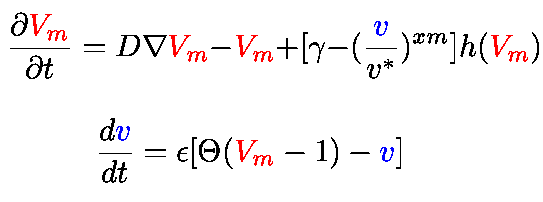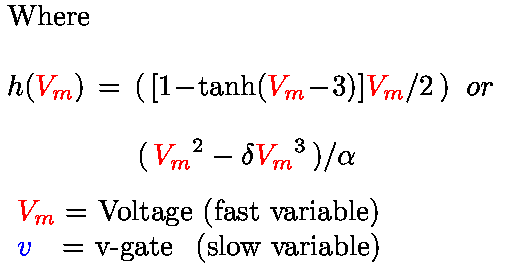

This applet shows the membrane potential produced by a cell using the Karma model as a function of time after it is stimulated above its threshold for excitation.
To use the applet, click the Start button to initiate the simulation and the Reset button to return the parameters to their initial values.
The Karma model is a simplified model that concentrates only on the collective behavior of all ionic currents rather than the detailed description of each one, and its aim is to reproduce mesoscopic properties of cardiac tissue such as APD restitution and conduction velocity restitution curves. The model is based on an analysis of the Noble model where the fast gate variables m and h have been eliminated adiabatically.
The model equations are:


The fast variable Vm represents the membrane potential and v represents the sodium channel slow inactivation and potassium channel slow activation, wich are combined by the Heaviside step function.
For this applet, the function h has the cubic form with delta = 0.23 and alpha = 7.5. The value of gamma is chosen such that the system has an excitatory fixed point (in this case gamma =1.92). The parameters to vary in the model are epsilon, which is a small parameter that relates the time scale of the upstroke with that of the maximum APD; xm , which describes the sensitivity of the wave front when propagating (as xm increases, dispersion decreases); and v*, which controls the APD pulse dynamics.
The action potential generated with this model has a more realistic fast upstroke and
slow recovery compared to that of the standard
FitzHugh-Nagumo model. Furthermore, it
reproduces the oscillatory pulse dynamics observed in experiments
with cardiac rings, which is one known mechanism for spiral wave breakup
in two and three dimensions. This breakup can be studied using the 2D applet of the Karma model.
More information about the Karma model:
Karma A. (1993) Spiral breakup in model equations of action potential propagation
in cardiac tissue. Phys Rev Lett 71, 1103-1106.
Karma A. (1994) Electrical alternans and spiral wave
breakup in cardiac tissue. Chaos 4, 461-472.